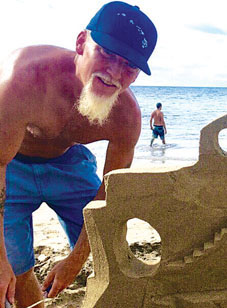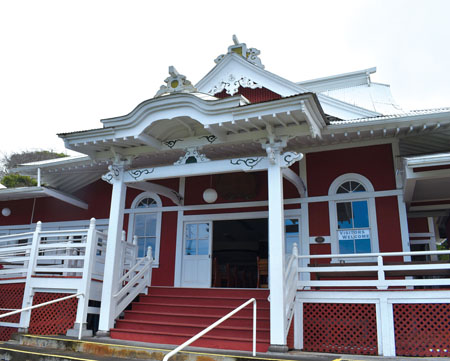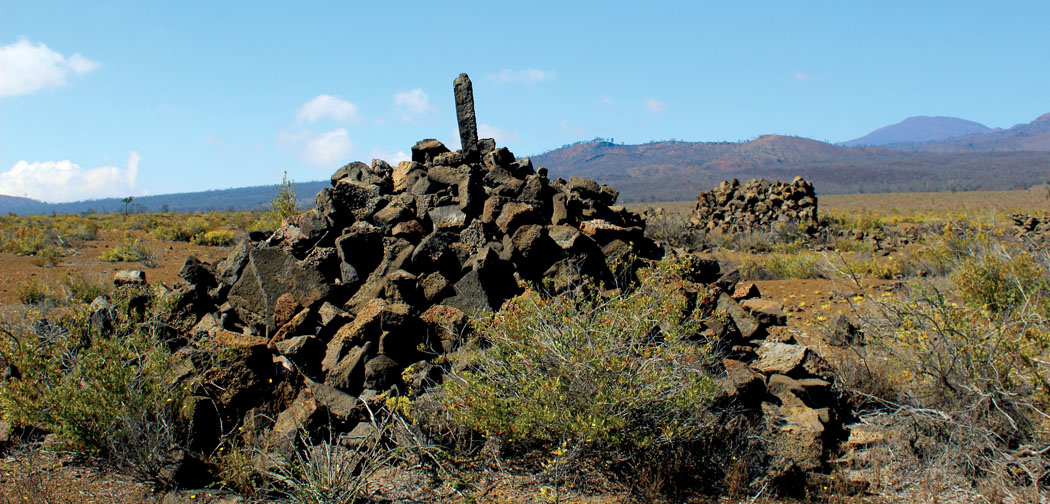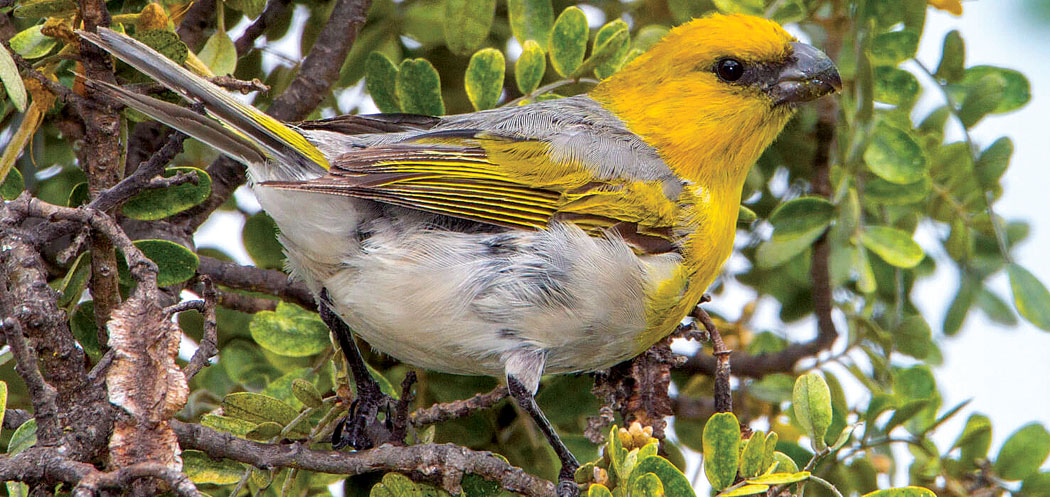
Hawai‘i’s Endangered Birds
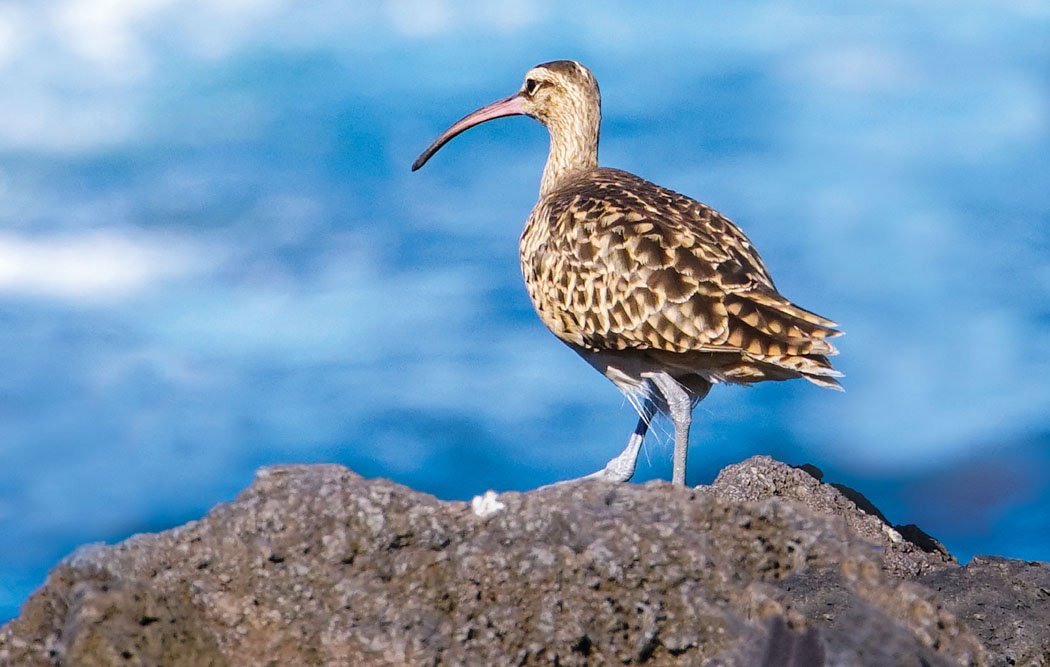
By Stefan Verbano
Hawai‘i’s islands were once tropical paradises for birds. Ten million years ago, the winged founders of Hawai‘i’s endemic bird populations touched down on a partially formed, mid-Pacific island chain markedly different than any humans have since “discovered.” From that moment up until first contact, 142 distinct bird species found nowhere else on earth roamed the archipelago.
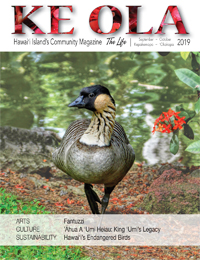
Among them were the Hawaiian honeycreepers, with their bright plumage and canary songs, which arrived here from the Sino-Himalayas region of eastern Asia, descending from a genus known as rosefinches found within the finch family. At least 56 species of honeycreepers existed during Hawai‘i’s undisturbed era, making up nearly half of its 115 total species of endemic land birds. Like the forest birds, migratory species have also used the islands as seasonal habitat for eons. Other lost, adventurous, or storm-driven pioneers came, too—together making up a group of as few as 20 total species from which all of Hawai‘i’s endemic birds would evolve.
Between 5.8 and 2.4 million years ago—almost concurrently with the formation of the island of O‘ahu—the vast majority of Hawai‘i’s unique honeycreeper species diverged from that first handful of finch-like new arrivals. They developed their own specialized feeding habits and, resultantly, specialized beak shapes to fulfill a wide variety of niches found on the newly-emerging, uninhabited islands they encountered springing up to the southeast.
In a very Darwinian-sounding tale, the honeycreepers underwent an extreme example of what evolutionary biologists call “adaptive radiation.” Isolated from their counterparts, with very few natural predators and an abundance of diverse food sources, the honeycreeper population soared, driven by mutational changes which allotted them beaks of many different sizes, shapes, and uses—parrot bills, warbler bills, finch bills, and others—to feed on a combination of forest fruits, seed pods, insects and nectar. Considering the degree of the honeycreepersʻ isolation and extent of their diversification, biologists remark that Charles Darwin’s famed Galapagos Islands finches pale in comparison to their Hawaiian relatives as the shining example of microevolution in action.
Today, all but 18 subspecies of Hawai‘i’s honeycreepers are extinct, including the mamo, po‘o-uli, kākāwahie, nukupu‘u, ‘akialoa, Lāna‘i hookbill, Kona grosbeak, as well most of the ‘ākepa subspecies. From species outside the honeycreeper pantheon, the honeyeaters kioea and ‘ō‘ō, the thrushes kāma‘o and ‘āmaui, the highly tame Laysan millerbird, the flightless Hawaiian rail, and Laysan rail are also gone forever.
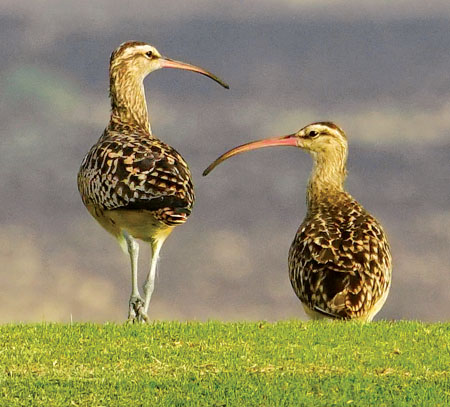
Of the 142 total endemic Hawaiian bird species from pre-history, 95 are now extinct; 33 of those remaining are listed under the US Endangered Species Act. Native shorebirds like the bristle-thighed curlew, and seabirds like the ‘ua‘u (Hawaiian petrel) and ‘a‘o (Newell’s shearwater) have each experienced plummeting populations, stuck with International Union for the Conservation of Nature (IUCN) classifications ranging from threatened to critically endangered, with habitat loss driving their decline.
Hawai‘i Island itself is home to several of these enduring species, some of them having become critically endangered in recent years. Various honeycreeper subspecies once inhabited broad swaths of the massive island’s wet and semi-dry mountain and lowland koa and ‘ōhi‘a forests. With no natural immunity to introduced mainland avian diseases, many of these once-abundant populations have been reduced to clinging to small patches of mountain forests above 5,000 feet—the elevation line where fowlpox and avian malaria-carrying mosquitoes can no longer survive. For migratory species with habitat on the island, their ancient homes have been crowded out by land development and polluted with artificial light, today only able to utilize small fragments of their historic range.
Conservation efforts for threatened native birds punctuate Hawai‘i Island’s modern history, such as the Shipman family’s well-known captive breeding of nēnē (Hawaiian goose) began in 1918 at the family’s coastal estate in Puna. Starting with just four birds, patriarch W. H. Shipman’s youngest son Herbert bolstered their numbers and ultimately saved the nēnē from near-certain extinction—considering that by 1952 only 30 wild birds remained of approximately 25,000, which biologists believe lived in Hawai‘i at the time of Captain Cook’s first arrival in 1778.
Nearly a century after Herbert Shipman’s successes, statewide inter-agency conservationists, with help from San Diego Zoo Global, launched the ‘Alalā Project to aid the captive-bred ‘alalā (Hawaiian crow), classified by IUCN as EW: Extinct in the Wild by working to restore its native habitat of endemic forest fruit trees and reestablishing a wild population on Hawai‘i Island.

Palila
With its golden yellow head and breast, light belly, gray back, and olive-green wings and tail, the critically endangered palila is one of the largest living Hawaiian honeycreepers. The six-inch-tall bird’s diet consists almost exclusively of immature seeds from māmane trees. Other occasional food sources include naio berries, various fruits, māmane flower buds and young leaves, along with caterpillars and moths.
The fates of the palila and māmane tree are inextricably linked. Two species found nowhere else on earth, the bird relies on the tree for food and habitat, as its hooked bill is perfect for opening māmane’s tough, fibrous seed pods. Droughts drive down the māmane seed crop, and in bad years palila don’t attempt to breed, as their reproductive success depends completely on the tree’s flourishing.
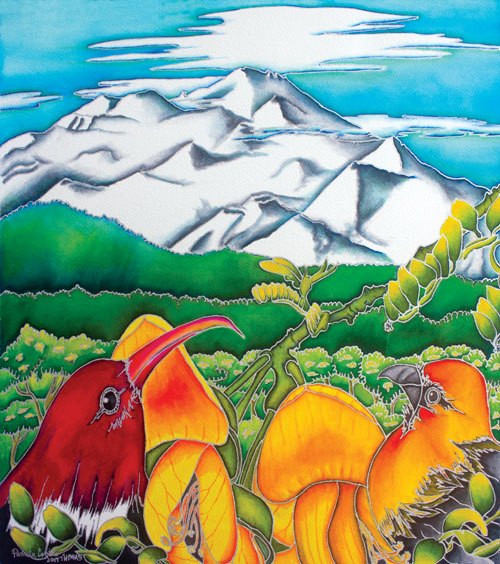
Palila were once found at a range of elevations on O‘ahu and Kaua‘i, in addition to Hawai‘i Island on flanks of the volcanoes Hualālai, Maunaloa, and Maunakea. But since the introduction of mosquitoes, sheep, pigs, cattle, goats, cats, rats, and mongooses, their eggs and nestlings have been eaten, the māmane saplings that are their lifeline have been uprooted and destroyed, and avian diseases have eroded their habitat down to less than five percent of the species’ historic range—now a 25-square-mile enclave on the upper slopes of Maunakea between 6,500 and 9,500 feet. As late as the 19th century, the birds were found down at elevations as low as 4,000 feet. This steep, steady decline in range has conservation biologists on edge: “It will happen until they have very little habitat left for them to survive in,” says Lainie Berry, the Hawai‘i Forest Bird Recovery coordinator at the Hawai‘i Department of Land and Natural Resources (DLNR) Division of Forestry and Wildlife. “We’re concerned in the immediate term to reverse these declines, but in the long term, we know we have to address the mosquito issue itself if the birds are going to survive into the future.”
The most recent palila count, in February 2018, tallied 1,000 birds—the lowest count in 20 years. The IUCN has listed the species as “critically endangered.” With their numbers flagging along with forests of māmane, the tiny flock is in a precarious position when considering the natural disaster-prone reputation of Hawai‘i Island.
“The population is very vulnerable to fire, hurricane, drought,” Lainie continues. “If something were to hit them, since the species isn’t spread out over a wide area, it could completely wipe them out.”
All hope is not lost for the palila. Conservation efforts like DLNR’s Maunakea Forest Restoration Project (MKFRP), which includes in its ranks native bird experts like Lainie Berry, are replanting forests of māmane, removing grazing animals from critical habitat areas, erecting a 6-foot-high, 60-mile-long continuous protective fence around the mountain, and breeding palila in captivity at the Keauhou Bird Conservation Center. MKFRP is a partnership of the US Forest Service, Natural Resources Conversation Service, American Bird Conservancy, and US Fish and Wildlife Service.
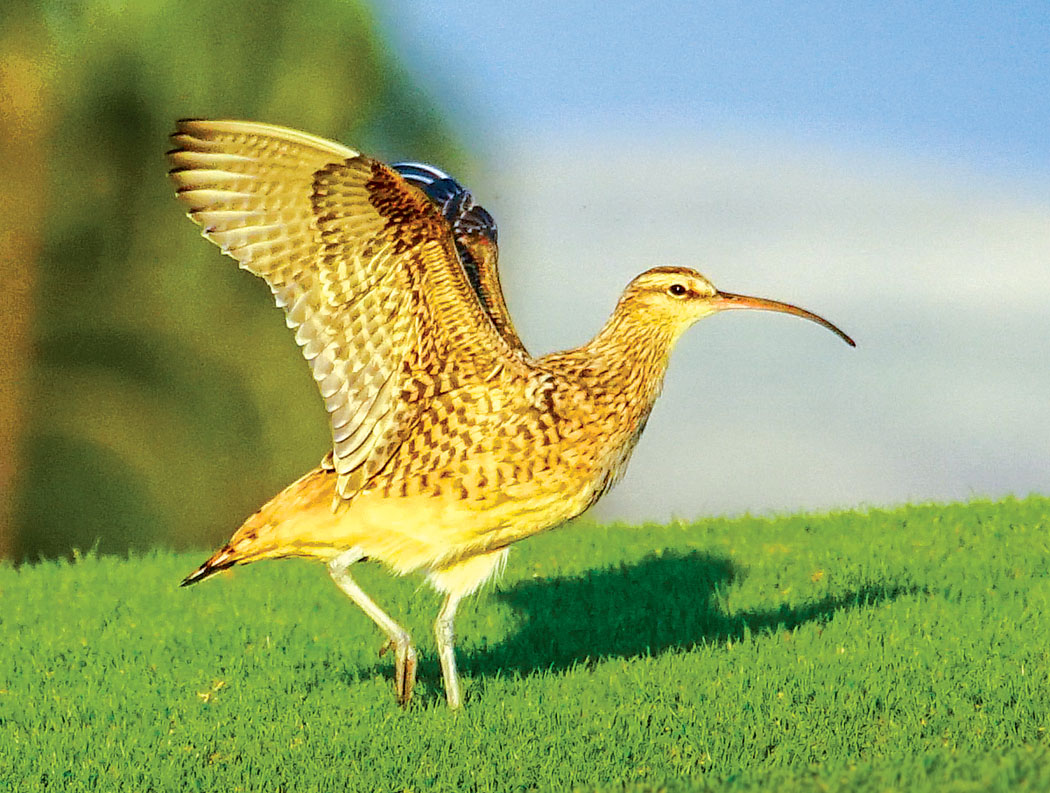
Bristle-Thighed Curlew (Hawaiian: Kioea, unrelated to the extinct honeyeater Kioea)
The migratory bristle-thighed curlew breeds on the lower Yukon River and Seward Peninsula in Alaska during summer months, and spends winters seaside in the tropical Pacific on Hawaiian and other Polynesian islands. A medium-sized shorebird in the sandpiper family, the curlew is spotted brown with light belly and rust-colored tail, a long curved bill and bristly feathers at the base of its legs. The birds mostly walk on the ground while foraging, having an affinity for flowers, berries, insects, sea life, and other birds’ eggs, which they open with rocks—the only shorebird to use tools.
Population estimates for the species hover around 7,000, with an IUCN listing of “threatened.” Their numbers on Hawai‘i Island’s Kona coast are just a tiny fraction of that. Currently, a flock comprised of less than a dozen birds left for Alaska this past May—all that remain of the curlew’s presence on Hawai‘i Island. Even this minuscule group of bent-beak shorebirds still faces threats from shoreline land development and predation by introduced species like cats, the latter largely due to the fact that many of the birds become flightless during molt. No one’s quite sure how many will return again from Alaska in August.
Meredith Miller, a Hawai‘i Island-based professional photographer, has happened upon the flock several times, using her camera skills to document these rare birds from afar in their increasingly man-made habitat.
“I’ve spent time with them; I’ve listened to them,” Meredith says. “I’ve heard them sing. I see their playfulness…how they interact with each other, their little fights…their hierarchy; theyʻre always trying to exert dominance over one another. They run on the long legs they have; they only fly when they have to,” she says. “But they are really strong flyers, and when they go, they go—they leave in a hurry.”
‘A‘o (Newell’s Shearwater)
Between April and November, seaside birdwatchers can spot the long-winged seabird known as Newell’s shearwater in ocean waters around the Hawaiian Islands. It’s black and brown on top with white under-parts, a thin hooked beak, and short tail, whose low, moaning call earned it the Hawaiian name ‘a‘o. It feeds far from land in deep water, diving in to catch squid and small fish, sometimes swimming down more than 150 feet using its wings to maneuver.
Endemic to Hawai‘i, these shearwaters breed in two dozen colonies on mountain slopes mostly on Kaua‘i, but also parts of Hualālai and Kīlauea on Hawai‘i Island. Their population, estimated at 84,000 in the mid-1990s, has severely declined, now numbering somewhere between 16,000 and 19,000 breeding pairs, with an IUCN status of “critically endangered.”
‘Akiapōlā‘au
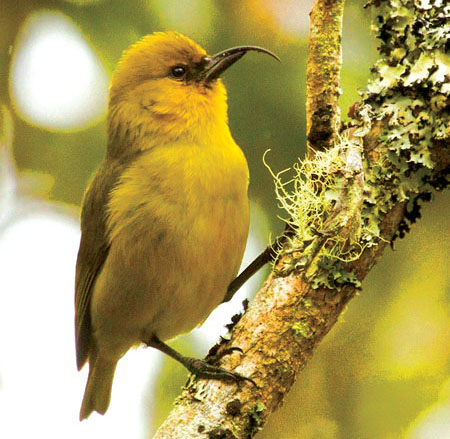
Inhabiting old-growth dry to moist koa and ‘ōhi‘a lehua forests in Ka‘ū and Hāmākua regions, the noisy ‘akiapōlā‘au has assumed the role of woodpecker on Hawai‘i Island, where itʻs endemic. The bird is pudgy, half-a-foot tall with whitish bottom and tail, black legs, yellow chest, orange head, black face, gray-black wings and an unusually curved beak, which it uses to pound and scratch at bark while hunting for caterpillars, spiders, and hiding grubs.
Since the disappearance—and presumed extinction—of the Maui and Kaua‘i nukupu‘u honeycreepers in the 1990s, ‘akiapōlā‘au appears to be the last of its genus. The bird’s habitat is similarly restricted by mosquitoes and predation by cats and dogs, which have dwindled its numbers down to approximately 1,000, with an IUCN status of “endangered.”
‘Elepaio

‘Elepaio, which isnʻt a honeycreeper, is the only member of more than 300 bird species in the Old World “flycatcher” family to successfully colonize the Hawaiian Islands on its own. It’s brown on top, white underneath, with white bars on dark wings and a long tail. Being one of the most adaptable native Hawaiian birds, ‘elepaio are fairly common on Hawai‘i Island and Kaua‘i, but rare on O‘ahu, where they were recently listed as endangered due to loss of habitat, introduced disease and predation.
As an insectivore with a loud warble, this monarch flycatcher hunts for food in koa trees. Ancient Hawaiian canoe builders came to rely on them as indicators of whether certain trees would make for suitable wood. Inquisitive and chatty, they seemed unafraid of humans, and often followed builders through the forest, who would watch the birds intently; if the ‘elepaio pecked at a certain tree, its wood was likely riddled with burrowing insects and therefore unusable. This inspired the Hawaiian proverb:‘Uā ‘Elepaio ‘ia ka wa‘a—The ‘elepaio has [marked] the canoe [log] (Mary Kawena Pukui, Olelo No‘eau 2777). ❖
For more information/Resources:
State of Hawai‘i Department of Land and Natural Resources, Division of Forestry and Wildlife: dlnr.hawaii.gov/wildlife/
US Fish and Wildlife Service: fws.gov/pacificislands/teslist.html
Hawai‘i Audubon Society: hawaiiaudubon.org/birding-in-hawaii
Mauna Kea Forest Restoration Project (MKFRP): dlnr.hawaii.gov/restoremaunakea/
The ‘Alalā Project: dlnr.hawaii.gov/alalaproject/
San Diego Zoo Global, Keauhou Bird Conservation Center: institute.sandiegozoo.org/who-we-are/global-field-stations
